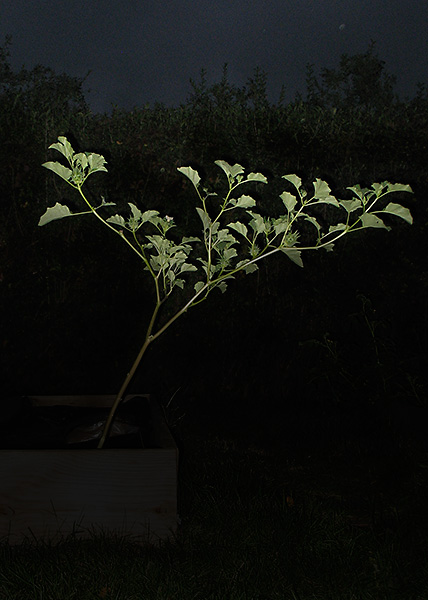
Date: October 12, 2013. Location: Garden - Iowa City, IA
| Classification Hierarchy | |
| Kingdom | Plantae |
| Subkingdom | Tracheophyta |
| Superdivision | Spermatophyta |
| Division | Magnoliophyta |
| Class | Magnoliopsida |
| Subclass | Asteridae |
| Order | Solanales |
| Family | Solanaceae |
| Genus | Datura |
| Species | Datura quercifolia |

Date: October 12, 2013. Location: Garden - Iowa City, IA
Scientific Name: Datura quercifolia
Synonym: Datura ferox auct. non L. (Fierce Thornapple, Long Spined Thornapple)
Grin comments that D. quercifolia Kunth is probably conspecific with D. ferox L.
Common Name: Oakleaf Thornapple or Chinese Thornapple.
Origin: Alien. D. quercifolia seems to have entered the U.S. from Mexico and has become naturalized in the southwestern states. The plant shown here arrived in Iowa as a contaminant in a commercial seed mix.
Notes: The vespertine (evening blooming) trumpet shaped flowers—sometimes called moonflowers or angel's trumpets are pollinated by hawkmoths. Jimson weed (Datura stramonium) is a close relative that is present in Iowa. All Datura species are notable for their toxicity to mammals. [See comments section below].
Additional references: 1, 2, 3, 4, 5, 6, 7, 8, 9, 10, 11, 12, 13, 14, 15, 16, 17.
Flowers: white when open, flowers and fruit are held upright, corolla trumpet shaped, 5 toothed, approximately 6 cm long; style with two lobed stigma; anthers 5 and hairy; after withering the corolla and calyx separate from the plant by abscission near the base of the calyx; the calyx base remnant then flattens, enlarges and turns downward forming a skirt around the pedicel; fruit capsule has stout spines which vary in size, the smallest near the base.
Leaves: varied—sometimes oak like, petiolate, margins lobed and sinuous, base oblique; youngest structures sparsely pubescent, older structures less so.
Glossaries of botanical terms: 1, 2, 3, 4, 5, 6, 7, 8, 9, 10, 11.
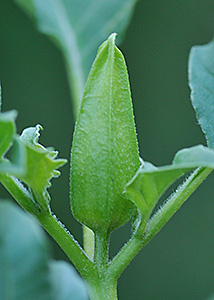
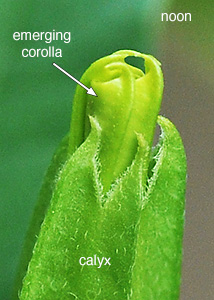
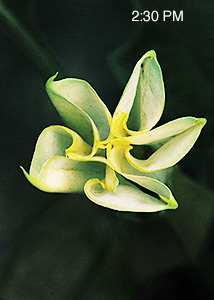
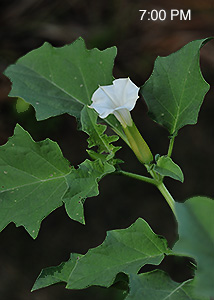
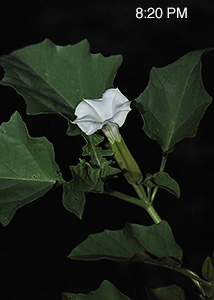
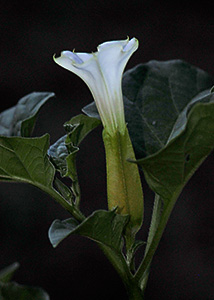
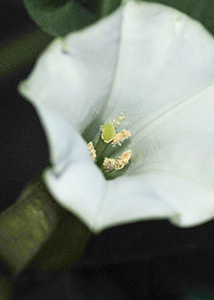
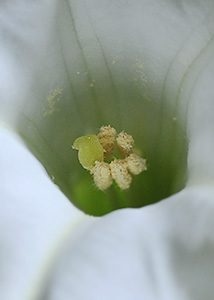
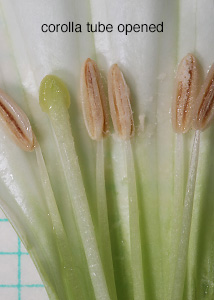
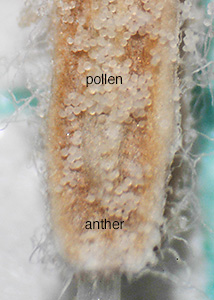
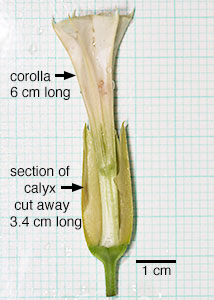
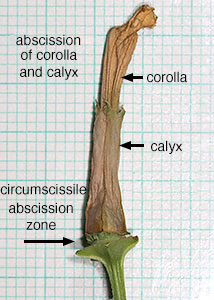
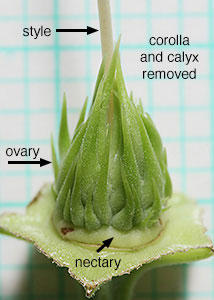
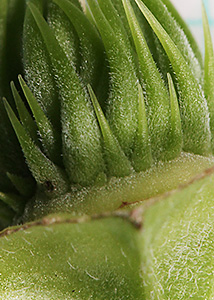
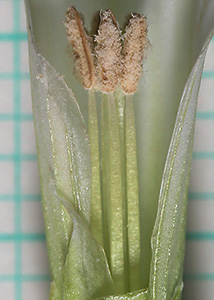
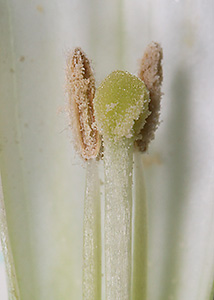
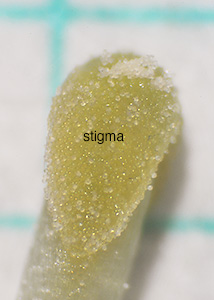
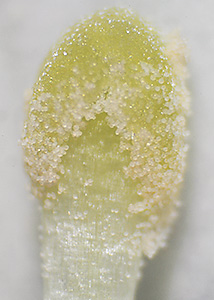
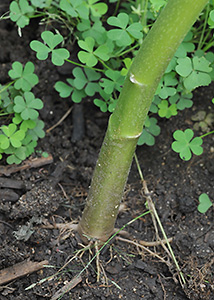
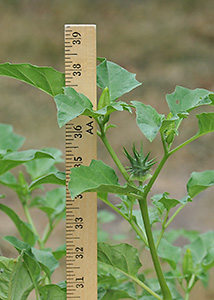
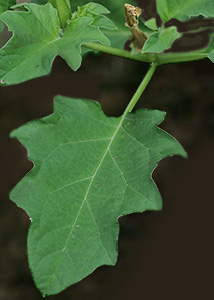
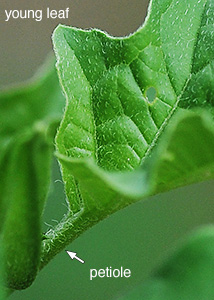
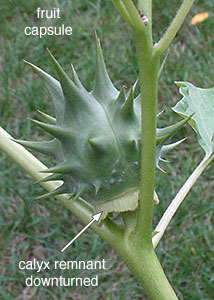
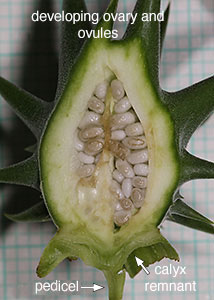
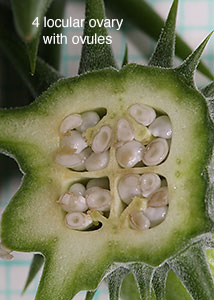
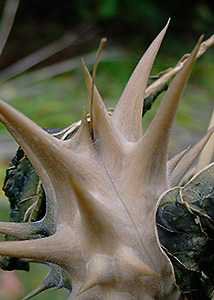
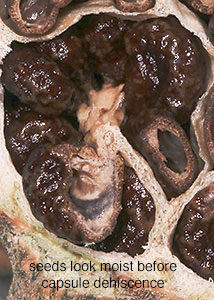
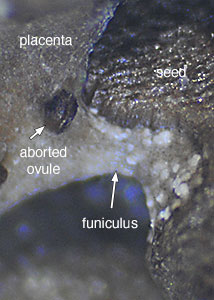
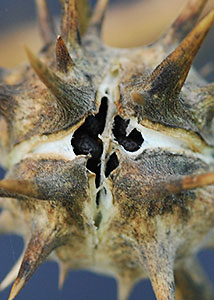
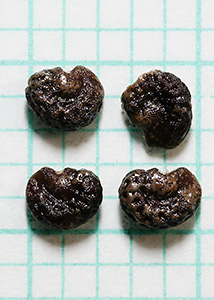
Comments:
Taxonomy: The FNA (Flora of North America) Project should soon publish the results of its study of the family Solanaceae with its 42 genera.
the genus of interest here (Datura) has 130 names to sort out. From these the number of accepted species will probably be pruned down to the single or double digits. Until those results are ready, a brief chronology of the taxonomic history of three names (stramonium, ferox, and quercifolia) may help explain some of the confusion surrounding Datura nomenclature and why the plant on this page could key out to D. ferox and still be named D. quercifolia.
1674, Italian botanist Paolo Boccone published an illustration of a plant from China and named it "Stramonium ferox".
1753, Carl Linnaeus introduced an organized system for naming plants with the publication of Species Plantarum in which he named every species of plant known at that time—including one he named Datura stramonium. This preserved part of Boccone’s original name for the plant in his 1674 illustration and coincidently is the most widely distributed Datura (jimsonweed) in the U.S. and in Iowa. [For more details see: Hadkins et al. (in Bot. J. Linn. Soc. 125: 296-298. 1998), including an illustration of the lectotype (as f. 2); also see The Linnaean Plant Typification Project for D. stramonium - L. nunc vulgaris per Europam means "now common in Europe". (the download may be slow)].
1756, Carl Linnaeus names Datura ferox L. (habitat is China). This preserves the second part of the name Boccone used for his illustration and is thought to be the same species as the illustrated plant. Hence, "Stramonium ferox" became correctly named, according to the new Linnaean system as Datura ferox L.
1983 Hammer et al. designated Boccone’s illustration as a lectotype—the nomenclatural type for the plant which Linnaeus had named Datura ferox L. in 1756. [For more details see: Hadkins et al. (in Bot. J. Linn. Soc. 125: 300-303. 1998), including an illustration of the lectotype (as f. 9)].
1818, The third plant (Datura quercifolia Kunth) was found in Mexico and named and published by H.B.K. (Humboldt, Bonpland & Kunth). Since most of the descriptive text was written by Kunth, it is, by convention, his name that follows the binomial (i.e. Datura quercifolia Kunth).
The New York Botanical Garden provides a virtual on-line herbarium with plenty of named specimens to look at: (downloads are slow) D. stromanium, D. ferox, D. quercifolia) but the relationship between the plants awaits the judgements of the FNA experts. Differences of opinion exist, for example, The Plant list website lists Datura ferox L. as an accepted name and lists Datura quericifolia Kunth as a synonym but if you search for Datura ferox L. in the USDA database you will be taken to the page for Datura quercifolia. Click on the synonym tab and you see Datura ferox auct. non L. This indicates that many people are making a wrong identification. They are looking at D. quercifolia and calling it D. ferox. In at least one case ferox is named a subspecies of D. stramonium. Possibly the FNA study will make clear the distinction between the Chinese plant that Linnaeus named Datura ferox L. and the plant that is being mistaken for it—apparently D. quercifolia—it would also be interesting to know why the plant found in Mexico is called Chinese thorn-apple. A comment on Datura origins would also be interesting.
Ethnobotany: Datura species are globally distributed (map, list). The alkaloids they produce protect them from herbivores and parasites and are also toxic to mammals. Consequently, they are dangerous and sometimes deadly when ingested by farm animals or humans. The very compounds that make them unsafe to eat have proven useful to physicians, shamans, and to the occasional villain. Of particular interest to physicians (and mystery writers) are the tropane alkaloids especially atropine, hyoscyamine, and scopolamine.
Under certain circumstances jimson weed will act as a deliriant or hallucinogen. One such incident [scroll down to book 2 page 24] occurred in Jamestown in 1676 after British soldiers ate a boiled salid containing the leaves of Jamestown weed (shortened to jimson weed). The soldiers demonstrated very strange behavior, took 11 days to recover, and retained no memories of the incident. This was most likely the result of the tropane alkaloids in the jimson weed. Most recreational drug users who have experimented with the deliriant/hallucinogenic properties of Datura plants describe the experience as sufficiently dangerous and frightening that they don't wish to repeat it.
Between the 14th and 18th century and across the globe, hundreds of thousands of people were burned, hanged, or tortured as practitioners of witchcraft. A belief in sorcery and certain religious convictions were used to justify the persecution of anyone behaving unusually.
The book Napoleon's buttons - 17 molecules that changed history—which is a very readable discussion of those events—suggests that the peculiar behavior that prompted persecutions may have resulted from the use of Datura species and several other members of the Solanaceae family e.g. Mandrake, Belladonna (Deadly Nightshade), and Henbane. These plants, known collectively as "witches' weeds", provided the ingredients for oily salves called (flying salves), the use of which may have caused some users to hallucinate that they were flying and to believe that they were witches. Others were tortured until they confessed to being witches. The website erowid.org provides information about plants in the Solanaceae family and anecdotal reports of human experiences with these plants.